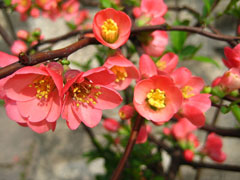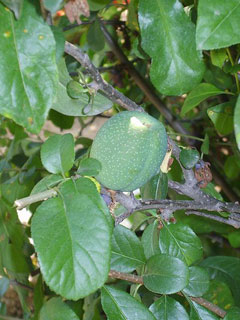 |
|
http://commons.wikimedia.org/wiki/File:Chaenomeles_speciosa_01.JPG |
 |
| http://commons.wikimedia.org/wiki/User:Dalgial |
Translate this page:
Summary
Flowering quince is a deciduous or semi-evergreen shrub with attractive flowers growing to 3 m (9ft). The fruit is cooked. It is very harsh and acid raw but fragrant when cooked. Used for jams, jellies etc. and as a flavouring with cooked apples. The fruit can be apple or pear-shaped and up to 6.5cm long x 6.5cm wide. The fruit is improved by a cold spell becoming softer. Flowering quince juice contains 150 mg of vitamin C, more than lemons. Flowering quince has medicinal properties and can be grown as a hedge. Bloom Color: Pink, Red, White.
Main Bloom Time: Early spring, Early winter, Late spring, Late winter, Mid spring, Mid winter. Form: Vase.
Physical Characteristics

 Chaenomeles speciosa is a deciduous Shrub growing to 3 m (9ft) by 5 m (16ft) at a medium rate.
Chaenomeles speciosa is a deciduous Shrub growing to 3 m (9ft) by 5 m (16ft) at a medium rate.
See above for USDA hardiness. It is hardy to UK zone 5 and is not frost tender. It is in flower from February to June, and the seeds ripen in October. The species is hermaphrodite (has both male and female organs) and is pollinated by Bees.
It is noted for attracting wildlife.
Suitable for: light (sandy), medium (loamy) and heavy (clay) soils, prefers well-drained soil and can grow in heavy clay soil. Suitable pH: mildly acid, neutral and basic (mildly alkaline) soils. It can grow in full shade (deep woodland) semi-shade (light woodland) or no shade. It prefers moist soil. It can tolerate atmospheric pollution.
UK Hardiness Map
US Hardiness Map
Synonyms
C. laganaria. Cydonia lagenaria. Cydonia speciosa. Pyrus japonica. non Thunb.
Plant Habitats
Woodland Garden Sunny Edge; Dappled Shade; Shady Edge; not Deep Shade; Ground Cover; Hedge; South Wall. By.
Edible Uses
Edible Parts: Fruit
Edible Uses:
Fruit - cooked[3, 4, 177]. Very harsh and acid raw but fragrant when cooked[1, 11]. Used for jams, jellies etc and as a flavouring with cooked apples[183, K]. The fruit can be apple or pear-shaped and up to 6.5cm long x 6.5cm wide[200].
References More on Edible Uses
Medicinal Uses
Plants For A Future can not take any responsibility for any adverse effects from the use of plants. Always seek advice from a professional before using a plant medicinally.
Analgesic Antiemetic Antiinflammatory Antispasmodic Astringent Cholera Digestive
The fruit is analgesic, anti-inflammatory, antispasmodic, astringent and digestive[147, 218, 238]. A decoction is used internally in the treatment of nausea, joint pains, cholera and associated cramps[147, 218, 238].
References More on Medicinal Uses
The Bookshop: Edible Plant Books
Our Latest books on Perennial Plants For Food Forests and Permaculture Gardens in paperback or digital formats.

Edible Tropical Plants
Food Forest Plants for Hotter Conditions: 250+ Plants For Tropical Food Forests & Permaculture Gardens.
More

Edible Temperate Plants
Plants for Your Food Forest: 500 Plants for Temperate Food Forests & Permaculture Gardens.
More

More Books
PFAF have eight books available in paperback and digital formats. Browse the shop for more information.
Shop Now
Other Uses
References More on Other Uses
Cultivation details
Landscape Uses:Border, Espalier, Hedge, Massing, Woodland garden . Easily cultivated in any reasonably good soil[1, 11]. Prefers a deep moist well-drained loam[11]. Grows well in heavy clay soils. Tolerates full shade but requires a sunny position for best fruit production[3, 11, 200]. Becomes chlorotic on very alkaline soils[200]. Tolerates atmospheric pollution[200]. This species is hardy to about -25°c[200]. Plants fruit freely in Britain, but the fruit does not always ripen. They do best when grown against a south-facing wall[11]. A very ornamental plant[1], there are many named varieties developed for their ornamental value[182, 183]. Closely allied to C. japonica[11]. A good bee plant, flowering early in the year and providing pollen and nectar[108]. Plants in this genus are notably resistant to honey fungus[200]. Special Features:Not North American native, Attractive flowers or blooms. The plant is heat tolerant in zones 9 through 1. (Plant Hardiness Zones show how well plants withstand cold winter temperatures.
Plant Heat Zones show when plants would start suffering from the heat.
The Plant Heat Zone map is based on the number of "heat days" experienced in a given area where the temperature climbs to over 86 degrees F (30°C).
At this temperature, many plants begin to suffer physiological damage. Heat Zones range from 1 (no heat days) to 12 (210 or more heat days).
For example Heat Zone. 11-1 indicates that the plant is heat tolerant in zones 11 through 1.) For polyculture design as well as the above-ground architecture (form - tree, shrub etc. and size shown above) information on the habit and root pattern is also useful and given here if available. The plant growth habit is multistemmed with multiple stems from the crown [1-2]. In garden design, as well as the above-ground architecture of a plant, root structure considerations help in choosing plants that work together for their optimal soil requirements including nutrients and water. The root pattern is branching: a heart root, dividing from the crown into several primary roots going down and out [2-1].
References Carbon Farming Information and Carbon Sequestration Information
Temperature Converter
Type a value in the Celsius field to convert the value to Fahrenheit:
Fahrenheit:
The PFAF Bookshop
Plants For A Future have a number of books available in paperback and digital form. Book titles include Edible Plants, Edible Perennials, Edible Trees,Edible Shrubs, Woodland Gardening, and Temperate Food Forest Plants. Our new book is Food Forest Plants For Hotter Conditions (Tropical and Sub-Tropical).
Shop Now
Plant Propagation
Seed - best sown as soon as it is ripe in a sheltered position outdoors or in a cold frame[200]. Sow stored seed in February in a greenhouse[78]. Germination usually takes place within 6 weeks[78]. Prick out the seedlings into individual pots as soon as they are large enough to handle. If well grown, these seedling can be large enough to plant out in the summer, but give them some protection in their first winter. Otherwise plant them out in late spring of the following year[K]. Cuttings of half-ripe wood, July/August in a frame[11]. Easy[113]. Cuttings of mature wood of the current year's growth, November in a cold frame. Layering in late spring or in autumn. This is a sure and easy method, though it takes 12 months[78, 200].
Other Names
If available other names are mentioned here
Zhoupi Mugua, Wrinkled-skinned quince, Japonica, Suomugua,
Native Range
TEMPERATE ASIA: Fujian Sheng, Gansu Sheng, Guangdong Sheng, Guizhou Sheng, Hubei Sheng, Jiangsu Sheng, Shaanxi Sheng, Sichuan Sheng, Xizang Zizhiqu, Yunnan Sheng,China. TROPICAL ASIA: Myanmar (north),
Weed Potential
Right plant wrong place. We are currently updating this section.
Please note that a plant may be invasive in one area but may not in your area so it's worth checking.
Conservation Status
IUCN Red List of Threatened Plants Status :

Growth: S = slow M = medium F = fast. Soil: L = light (sandy) M = medium H = heavy (clay). pH: A = acid N = neutral B = basic (alkaline). Shade: F = full shade S = semi-shade N = no shade. Moisture: D = dry M = Moist We = wet Wa = water.
Now available:
Food Forest Plants for Mediterranean Conditions
350+ Perennial Plants For Mediterranean and Drier Food Forests and Permaculture Gardens.
[Paperback and eBook]
This is the third in Plants For A Future's series of plant guides for food forests tailored to
specific climate zones. Following volumes on temperate and tropical ecosystems, this book focuses
on species suited to Mediterranean conditions—regions with hot, dry summers and cool, wet winters,
often facing the added challenge of climate change.
Read More
Expert comment
Author
(Sweet.)Nakai.
Botanical References
11
Links / References
For a list of references used on this page please go here
Readers comment
© 2010, Plants For A Future. Plants For A Future is a charitable company limited by guarantee, registered in England and Wales. Charity No. 1057719, Company No. 3204567.